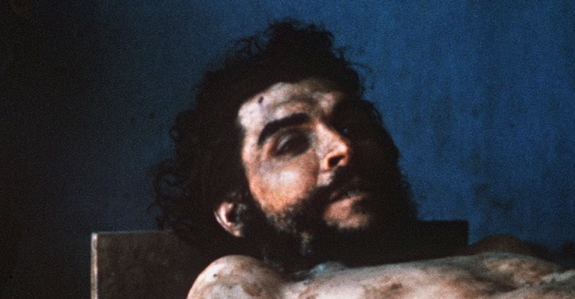
Che Guevara's legacy still contentious 50 years after his death in Bolivia
October 5, 2017 - The Guardian
The remote village where the Argentina-born revolutionary was executed is now a tourist attraction but the fortunes of his regional political heirs are on the wane
by Laurence Blair
On 3 November 1966, a middle-aged Uruguayan businessman named Adolfo Mena González touched down in La Paz, Bolivia. He took a hotel suite overlooking the snowbound heights of Mount Illimani, and photographed himself – overweight, balding, lit cigar in his mouth – in the mirror.
In reality, however, he was none other than Ernesto "Che" Guevara – the Argentina-born revolutionary who helped topple Cuba's US-backed dictator, lectured the United States from a UN lectern, penned treatises on Marxism and guerrilla warfare, and sought to export socialism worldwide.
Eleven months later, another image of Guevara would spread around the world, showing his scrawny, lifeless body on a stretcher, his full head of hair and beard unkempt, and his eyes wide open.
"They said he looked like Christ," said Susana Osinaga, 87, a retired nurse who helped wash the dirt and blood off Guevara's body. "People today still pray to Saint Ernesto. They say he grants miracles."
Next Monday marks the 50th anniversary of Guevara's death on 9 October 1967 – an event which Bolivia's current left wing president, Evo Morales, will commemorate with a host of events including a "Relaunching of the Anti-Imperialist Struggle".
But the date is also prompting less triumphant reflections on Guevara's legacy at a time when the Latin American left – guerrillas and democrats alike – is in full retreat.
After a failed expedition to the Congo in 1965, Guevara alighted on Bolivia as the launchpad for regional, then global, revolution. "In retrospect you can perceive a certain naivety; an almost crass idealism," Jon Lee Anderson, author of the definitive 1997 biography Che Guevara: A Revolutionary Life, told the Guardian.
But in the febrile atmosphere of the 1960s, anything seemed possible. "If there was ever a time in the modern era to pull something like that off, it was then," Anderson added.
Yet things went wrong soon after Che and his column of 47 men arrived in the arid, thorny Ñancahuazú region. They lost radio contact with Cuba, supplies ran low. They were plagued by illness and vicious insects.

The Bolivian recruits resented taking orders from the battle-hardened Cubans, and government propaganda sowed fear of the foreign interlopers among the campesinos. The United States soon got wind of Guevara's presence and sent CIA agents and military advisers to assist the regime of René Barrientos.
On 31 August an army ambush wiped out half of Che's forces. The remainder trudged towards the mountains in a desperate attempt to break out of the trap.
Che, prostrated by asthma, rode on a mule towards the remote village of La Higuera. A local farmer informed on them – and amid a frantic gunfight, a bullet destroyed the barrel of Guevara's carbine. Wounded, he surrendered to a battalion of rangers – trained by US Green Berets – under the command of a 28-year-old captain, Gary Prado.
"Don't shoot – I'm Che. I'm worth more to you alive," Guevara reportedly said.
In an interview with the Guardian, Prado recalled that moment. "I felt pity because he looked so poor, so tired, so dirty," said Prado. "You couldn't feel he was a hero, no way."
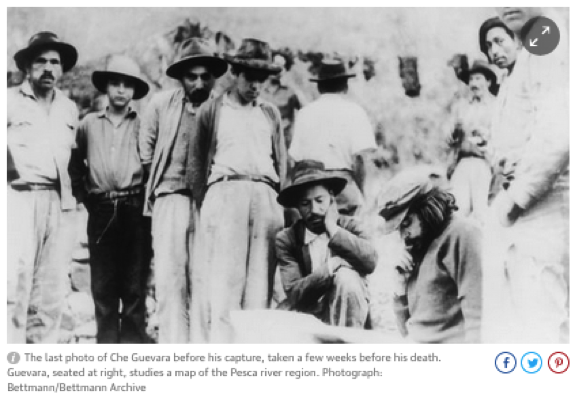
Guevara and his captured comrade, Simeón "Willy" Cuba Sarabia, were escorted to La Higuera and held in separate rooms of the schoolhouse. Prado had several conversations with Guevara, and says he brought him food, coffee and cigarettes. "We always treated him with respect. We had nothing against him even though we had [had] soldiers killed," he claimed.
When Guevara asked what would happen to him, Prado said he told the guerrilla that he would be court-martialled in the city of Santa Cruz.
"He found it interesting, the idea that he might have a chance in court," Prado said.
The trial never happened. According to Prado, orders came the next day to "get rid of him".

A 27-year-old army sergeant, Mario Terán, volunteered for the job, and ended Guevara's life with two bursts of machine-gun fire. After being flown by helicopter to nearby Vallegrande and displayed for the world's press, Che's body – minus his hands – and his companions were buried in unmarked graves. They wouldn't be found for 30 years.
Although Prado insisted he had no role in Guevara's killing, he maintained that such conduct was common at the time, citing the judicial executions overseen by Guevara after the Cuban revolution.
"He was executed, that was reprehensible. But you have to think about things at the moment that they happened … in that moment, it was justified," he argued.
Today, bullet marks score the rocks where most of Guevara's Ejército de Liberación Nacional (ELN) comrades were gunned down. The boulder behind which Che sheltered is daubed with graffiti.
Farming tools rust among the overgrown foliage. The hut of an old woman mentioned by Che in his diary – today kept in a vault in the Central Bank of Bolivia – is in ruins. The village was once home to about 75 families; today 15 or so remain.
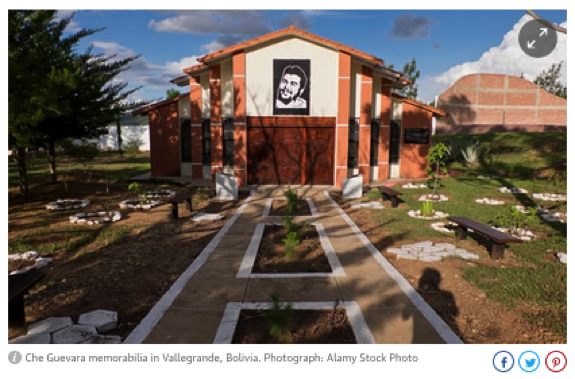
Cleto Zárate, a 14-year-old boy in 1967, remembers blocking up the door with mattresses as Che's column stalked down the track outside. The guerrillas' ammunition was poisoned, he insists.
"We were told they were going to rape the women, steal the children, and kill all the old people," recalls Cresencia Zárate, then a 15-year-old newlywed. Alcides Osinaga, 73, saw the captured Guevara pass by in rags, covered in filth, head bowed, bleeding from his wounds.
Despite his hostile reception at the time, Che's fleeting presence here 50 years ago has given a lifeline to La Higuera. Half a dozen hostels have sprung up in the village. "If Che hadn't come here, none of us would have jobs," explains a custodian of the renovated schoolhouse where Che was executed. Inside, every surface is covered with tributes and keepsakes from pilgrims from all over the world.
A cottage Che industry has also taken root in Vallegrande. Guides ferry tourists around the hospital laundry where his body was displayed and the formerly unmarked tombs where he and his comrades were buried.
Gonzalo Gúzman, a local guide, was part of the team who discovered Che's remains, during a search sparked by Anderson's biography. "At the time I didn't know who Che was. The Cuban investigators told us, 'you're now part of history,'" Gúzman says, inside the new mausoleum built over the gravesites.
This dribble of international tourism will turn into a flood in the days leading up to 9 October this year. Some 10,000 people are expected to descend on La Higuera and Vallegrande, among them social activists, regional leaders, Cuban functionaries – and Che's children.
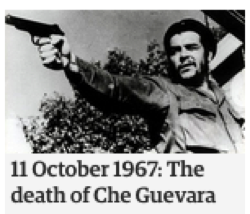 Festival-style infrastructure is being set up on the abandoned airstrip. Workers are smartening up a newly built Che Guevara Cultural Centre and frantically improving the power lines to La Higuera, where a Cuban doctor and nurse are repainting Che-related monuments.
Festival-style infrastructure is being set up on the abandoned airstrip. Workers are smartening up a newly built Che Guevara Cultural Centre and frantically improving the power lines to La Higuera, where a Cuban doctor and nurse are repainting Che-related monuments.
The anniversary comes at a tough time for Guevara's inheritors. It follows five years in which progressive governments have fallen to centre-right administrations in quick succession, including in neighbouring Argentina, Brazil, Peru and Paraguay.
Venezuela – whose late president Hugo Chávez revived Guevara's dream of a united, socialist continent – is now stalked by hunger, shortages of basic goods, and a sky-high murder rate. The "pink tide" leaders scheduled to gather in Bolivia next week – among them Argentina's embattled former president, Cristina Fernández de Kirchner, and Ecuador's Lenín Moreno – will make for a diminished group.
Guevara's violent route towards social justice is also going out of fashion. After 53 years of armed struggle (and other, less noble activities), the largest rebel army in the region – the Revolutionary Armed Forces of Colombia – handed in their weapons earlier this year.
Mexico's Zapatista movement renounced violence in August while the Maoist leaders of Peru's Shining Path languish in jail. In Brazil, Uruguay and Central America, former guerrilla leaders have – in recent decades – traded bullets for ballots.
And Guevara's former comrades-in-arms are fast succumbing to a more implacable enemy than Washington: old age. Fidel Castro, the steely political operator to Guevara's hot-headed visionary, died in late 2016. His 89-year-old successor and brother, Raúl Castro, has promised to step down early next year.
Attitudes are changing with the times. The United States' regional standing has diminished since Donald Trump assumed office, but according to the Pew Research Center, Latin Americans aged 18-29 are still considerably more likely to approve of the North American superpower than their elders, with 72% of young Brazilians viewing the US favourably in 2017.
The anniversary also comes at a turning point for Bolivia. After a decade of growth and rapid poverty reduction, a plunge in oil prices and a series of political blunders have cost Morales support.
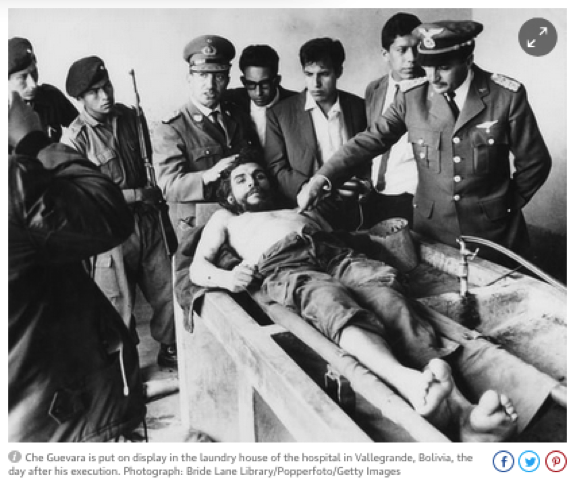
Local politicians in Vallegrande – opponents of Morales – have done little to promote Che-related tourism, said Gúzman.
At a civic event two weeks before the anniversary, a local councillor rattled off a list of local eminences. "We don't have to look abroad," she said, in a pointed allusion to Che. Members of Bolivia's military have also protested about being forced to pay homage to the guerrillas who were once their sworn enemies.
For some, however, Che has lost none of his lustre, and his struggle in eastern Bolivia wasn't a fruitless enterprise. "It all depends on how you measure success," says Héctor Urdaeta, co-author of a book on Bolivia's ELN and a leader of the country's Guevarista Movement. "We don't rule out armed struggle in the future," he said.
Gúzman also defends the legacy of the man whose bones he helped to find.
"You can't put Che down," he said, walking among the ripe citrus, avocado and custard apple trees that now fill the ravine where the Argentinian revolutionary fought his last battle. "For us, he's a hero."